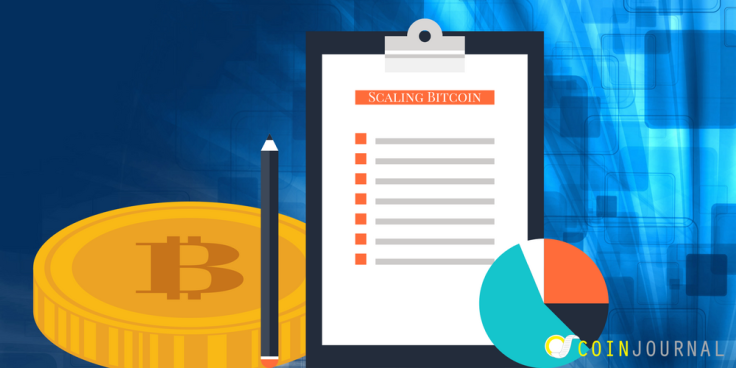Bitcoin survey shows 71% support SegWit and UASF popularity growing
CoinJournal asked 1,100 respondents to choose SegWit, Bitcoin Unlimited or another option.

A survey of the Bitcoin community found that 71% of over 1,100 respondents are in favour of implementing SegWit (segregated witness) as the best way to address the cryptocurrency's scaling problem.
The survey carried out by CoinJournal also detected support for a user activated soft fork (UASF), which would remove the political burden of decision making from Bitcoin's miners.
The main contender to SegWit is Bitcoin Unlimited, which roughly 18% of respondents opted for, while around 11% said they preferred another solution. As a side note, 74% of respondents claimed to be bored of the scaling debate.
While Bitcoin's market cap continues to swell, the protocol is unable to cope with the volume of transactions on the network, leading to a backlog and rising transaction fees.
SegWit introduces a new transaction format and updates the 1MB block size limit to a four million-unit block weight limit, counting serialised witness data as one unit and core block data as four units. Data don't get smaller, but instead, are counted in a way that allows for the 1MB limit to be effectively increased.
In addition to capacity increase, SegWit would fix transaction malleability, an attack that lets a person change a Bitcoin transaction's unique ID before the transaction is confirmed on the Bitcoin network. It also paves the way for layer-two payment systems like the Lightning Network.
The current deployment of SegWit requires 95% miner approval in order for the upgrade to be activated. But so far only 30% of miners have signaled support.
BIP 148, has started to gain some traction. Under this proposal, which is still controversial, users would activate SegWit on their own in an attempt to incentivize miners to do the same.
In contrast to a carefully measured block size increase, Bitcoin Unlimited advocates complete freedom and flexibility, and allows miners and users to come to consensus on a block size limit on the fly. Concretely, this means that miners and users can signal which block size limit they prefer and decide to converge at an agreed upon number.
Opponents argue that such flexibility can result in miners opting for bigger and bigger blocks, making it harder for miners with limited resources to mine, and thus, concentrating the mining power in the hands of a few miners.
Implementing Bitcoin Unlimited would require a hard fork of the Bitcoin Core software, posing the risk of a split in the network where people decide to continue to work on both protocols, thus creating two separate blockchains.
Bitcoin Unlimited wants to have an approval rate of 75% before implementing the fork. If the quote is met and held for a certain period of time, the hard fork will be implemented — but miners cannot force users to follow their lead.
Other proposals that have been popular over time include: Bitcoin XT, the 8MB block size limit backed by Mike Hearn and Gavin Andresen; and Bitcoin Classic, which attempted to move the technical governance of the Bitcoin project from the developers of Bitcoin Core to a voting process involving the largest community of miners, businesses, developers and users.
A recent proposal which gained traction at Consensus 2017 was tabled by Digital Currency Group which saw some 50 Bitcoin companies sign an agreement, including Bitcoin.com, Blockchain, Coinbase, ShapeShift, as well as major mining players like Bitmain and BitFury. The proposal includes lowering the barrier for the activation of SegWit to 80% of the network's mining power, and will rely on new software which is currently not developed.
Some prominent figures in the Bitcoin community commented on the choices. Samson Mow, CSO, Blockstream, said: "The Bitcoin scaling debate isn't really a debate at all. It's a coordinated effort to influence and control protocol development. Bitcoin is the first and most successful protocol for money, so the temptation and reward for various parties to control it is immense – especially businesses that are looking for short term results to induce an exit or liquidity event.
"Those short term goals are at odds with the Bitcoin developers who are working diligently on creating digital gold, which requires stability, maintaining backwards compatibility, and real scaling through engineering."
Josiah Hernandez, chief strategy officer of Coinsource, said: "Segwit is an elegant solution to a complex problem. It is the culmination of years of research, testing, and development that has already largely reached consensus among both bitcoin businesses and nodes. While providing a foundation for Layer 2 scaling solutions such as lightning network, it also offers an immediate way to help address upwards fee pressure and increased transaction confirmation times via an effective block size limit increase to 2MB. As is, it is the most ideal proposal in market."
Dr. Peter Rizun, chief scientist, Bitcoin Unlimited, said: "Many people are confused: bigger blocks and segwit are not mutually exclusive. Increasing the base block size limit is most urgent, as it will have the immediate effect of reducing fees and improving confirmation reliability. If there is real demand for segwit, we can have that too; it's not one or the other."
Emin Gün Sirer, Associate Professor, Cornell University, said: "I believe that the only serious proposal is one that is not on the table yet: can we evolve the protocol such that the bottleneck involved in block dissemination is eliminated? Bitcoin-NG showed that this is possible, and ByzCoin carried out additional science. In the long term, there is no doubt in my mind that advanced coins will adopt Bitcoin-NG-like techniques.
Sergey Ponomarev, CEO, SONM, said: "I stand for Segregated Witness. Bitcoin Unlimited and other solutions that are proposing an increase in block size will lead to the further centralisation of already centralized Bitcoin mining. Furthermore, I believe Segregated Witness is a more flexible way of solving Bitcoin's scaling issues because it uses a soft fork rather than a hard fork."
© Copyright IBTimes 2025. All rights reserved.






















